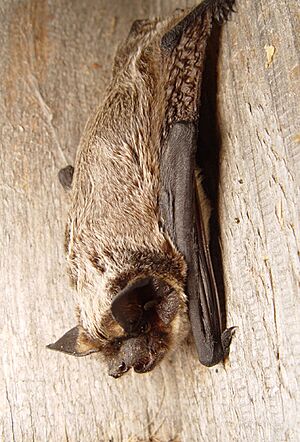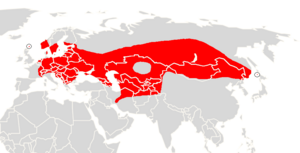Parti-coloured bat facts for kids
The parti-coloured bat (Vespertilio murinus) is a cool type of vesper bat. It lives across many parts of Eurasia, from Western Europe all the way to China and Pakistan. It's also known as the rearmouse.
Quick facts for kids Parti-coloured bat |
|
|---|---|
 |
|
| Conservation status | |
| Scientific classification | |
| Genus: |
Vespertilio
|
| Species: |
murinus
|
 |
|
| Range of V. murinus in Eurasia | |
| Synonyms | |
|
Eptesicus murinus (Linnaeus, 1758) |
|
Contents
What Does the Parti-coloured Bat Look Like?
These bats are named for their unique fur, which has two colors! Their back is reddish to dark brown, with silver-white tips on the hairs, making them look frosted. Their belly is white or gray. Their ears, wings, and face are dark brown or black.
A parti-coloured bat is about 4.8–6.4 centimetres (1.9–2.5 in) long. That's about the size of a small candy bar! Their wings can spread up to 26–33 centimetres (10–13 in), which is roughly the length of a school ruler. They weigh between 11–24 grams (0.39–0.85 oz), which is lighter than a small chocolate bar. These bats have narrow wings and short, broad, roundish ears. They can live for up to 12 years.
You might hear their calls, which sound a bit like a bird's twitter, especially in autumn during their mating season.
How Do Parti-coloured Bats Behave?
Parti-coloured bats hunt for their food after the sun sets. They fly at heights of about 20–40 metres (66–131 ft) (that's like flying over a 10-story building!). They like to hunt in open areas, over streams and lakes, above forests, or near street lights. They use special sounds called ultrasonic sounds to find their prey, like mosquitoes, caddis flies, and moths.
Not a lot is known about these bats because they are quite rare. Female bats usually live in small groups of about 50, but sometimes up to several hundred. In Western Europe, male groups can have around 250 bats, and they are mostly seen in spring and early summer.
These bats are known to travel long distances. Some have been found to fly up to 900 kilometres (560 mi), and the longest recorded journey was an amazing 1,780 kilometres (1,110 mi)!
Between October and March, parti-coloured bats go into hibernation. They sleep alone and can even survive in temperatures as low as −5 °C (23 °F).
Reproduction and Life Cycle
Female bats form special groups called maternity roosts between May and July. They usually give birth to two baby bats, called pups. The pups drink their mother's milk for less than six weeks. After they stop drinking milk, the mothers leave the maternity roost. In Western Europe, the babies are usually born around the beginning of June.
Where Do Parti-coloured Bats Live?
The parti-coloured bat lives in Central and Western Europe and in Asia. Their natural homes are in mountains, open grasslands (steppes), and forested areas. However, in Western Europe, they are often found living in cities.
This species is protected, meaning people are working to keep them safe. They are threatened by things like insecticides (chemicals used to kill insects) and changes to their homes.


